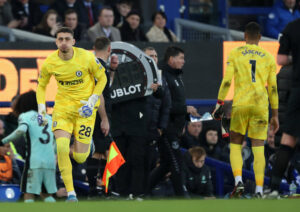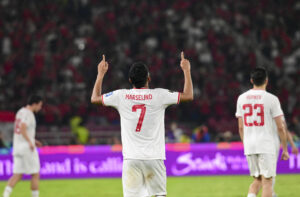Football in Serbia has undergone a major renaissance in recent years. The under-20 side won the World Cup in 2015, while their impressive qualification campaign led them to the World Cup. Their appearance at the finals will be only their second as an independent nation. Despite all the positivity in recent years, the Serbian faithful have been keeping their expectations low.
As Yugoslavia, they go a long way back at the World Cup, achieving a fourth-place finish in Chile in 1962. As Serbia and Montenegro, they only played one World Cup, exiting the tournament in the group stages. However, they did produce a fine consolation win against Germany during one of those campaigns.
Serbia: Putting The Promise Into Practice
Serbia Hopes
Now, they enter the tournament with an inspirational squad, full of ambition. However hopeful, that hope may be just that. The managerial situation coupled with administrative problems has therefore led to uncertainty. An unhealthy approach to the World Cup.
Serbia qualified as group winners in their qualification process. They finished ahead of Euro 2016 semi-finalists Wales as well as the Republic of Ireland. The win against the latter on the third-last matchday spurred them on. Using the advantage, earning direct qualification, and sending The Boys In Green to the play-offs.
Their campaign wasn’t attractive, but still effective. They scored 20 goals – the third-lowest – and conceded 10 – the second highest (both compared to other group winners).
The Manager
The pessimism surrounding this Serbia side comes through the volatility in management. The man that led them to qualification, Slavoljub Muslin, was sacked just three weeks after sealing qualification. His replacement was Mladen Krstajić a former defender who was part of the Serbia and Montenegro roster in 2006. One of the main reasons for Muslin’s sacking was his refusal to field the younger players. This was often the case with one Sergej Milinković-Savić, who has enjoyed a stellar season with Lazio.
In qualification, the setup Muslin stuck with was a back-three, taking advantage of the versatility and solidity available. The flat back-three included Branislav Ivanović and Aleksander Kolarov on either side of Nikola Maksimović.
They were supported by the two defensive midfielders ahead of them, Nemanja Matić and Luka Milivojević. The Premier League trident was complete, with Dušan Tadić played in the number 10 role. As wing-backs, Antonio Rukavina took up the right and Ivan Obradović on the left, while the outfield consisted of free-scoring Aleksandar Mitrović and Filip Kostić.
Krstajić, who replaced Muslin, kept a similar setup in the two friendlies that he was in charge. However, the results were not convincing. Against Nigeria, they were able to win 2-0, but against Morocco, Krstajić’s lack of managerial experience showed.
The lack of cohesion and uneven flow hindered Serbia as they fell to a 2-1 defeat. The problem is identifying the perfect spot for star man Milinković-Savić. The 23-year-old barely played in the qualifiers and didn’t feature in the two friendlies. With kick-off against Costa Rica in Samara looming, there is little time to experiment.
The Players
Despite the lack of playing time, it is expected that Milinković-Savić will start in Russia. Most likely behind Mitrović. Both have enjoyed fine seasons. The Lazio midfielder has been one of Serie A’s best footballers.
Mitrović made a loan move to Fulham in the winter transfer window, scoring 12 times in 17 appearances. Helping Fulham a rise back to the Premier League for the first time since 2014. He was heir top scorer in qualifying, netting six. The youngster will be the nominated hitman in Russia. The partnership, when at best, is explosive, their traits combining perfectly.
https://www.youtube.com/watch?v=a4YScaF4xGc
The average age of the preliminary 27-man squad selected is a low 25.9. A number that’s sure to drop once the final roster is drawn up. That comes largely through the youth of the midfield. The likes of Nemanja Maksimović, Marko Grujić and Andrija Živković are all alumni of Serbia’s successful U20 World Cup team. They provide different and unique qualities to the side.
Valencia’s Maksimović is likely to deputise to Matić and/or Milivojević in central midfield. Grujić and Živković, meanwhile, are more attack-minded, though the latter has also contributed on either wing for his club, Benfica.
The strength comes from the experience in defence. Captain Kolarov and former captain Ivanović will marshal the defence, bringing 175 national caps of experience. They’ll be aided by either Matija Nastasić or Antonio Rukavina.
Nastasić has done well for Schalke in Germany, despite being hampered by injury. Rukavina deputised decently in his absence. Either way, Serbia have enough strength and depth in their squad. A squad capable of challenging the elite.
The Prospects
Serbia are in a group with Brazil, Switzerland and Costa Rica. The obvious favourites to qualify will be the five-time champions, but second-place is achievable. Costa Rica will be buoyed by performances from the previous finals. Switzerland though, on paper, are their likeliest challengers for second place.
The Serbian advantage comes with the scheduling. They open with a clash against Costa Rica, then Switzerland. Finally facing Brazil on the last day. Ergo, gaining maximum points before their biggest challenge is vital.
Serbia On the Move
The team also has longer travelling times. Their base is in Kaliningrad, the venue for their second group match against Switzerland. However, they have to play in Samara against Costa Rica before that, on the other side of the country.
Serbia then travel back again to the capital, Moscow, for their clash with Brazil. Fatigue is sure to affect the side, something to be wary of during the tournament.
The target is to reach the second round. If successful, they’ll play the winners or runners-up of Group F. On paper, that’s likely to be defending champions Germany.
This clash itself carries history, bringing back successful memories from the 2010 build-up. For now though, there appears to be no doubt that this generation of players can make Serbia proud.






